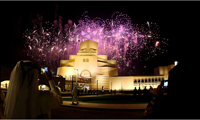 In Qatar, an Art Museum of Imposing Simplicity
In Qatar, an Art Museum of Imposing SimplicityBy NICOLAI OUROUSSOFF | Published: November 23, 2008
DOHA, Qatar — There is nothing timid about the ambitions of the new Museum of Islamic Art that opens here next week. Rising on its own island just off the city’s newly developed waterfront corniche, it is the centerpiece of an enormous effort to transform Qatar into an arts destination. The inaugural festivities on Saturday, including a performance by Yo-Yo Ma, attracted art-world luminaries from around the globe.
Art of IslamSlide Show Viewed under the light of a spectacular evening fireworks display, the museum’s colossal geometric form has an ageless quality, evoking a past when Islamic art and architecture were a nexus of world culture. At the same time it conveys a hope for reconnecting again.
The building seems austere by the standards of the flashy attention-grabbing forms that we have come to associate with Persian Gulf cities like Dubai and Abu Dhabi. Designed by I. M. Pei, 91, who has described it as his last major cultural building, it recalls a time when architectural expression was both more earnest and more optimistic, and the rift between modernity and tradition had yet to reach full pitch.
The museum, which houses manuscripts, textiles, ceramics and other works mostly assembled over the last 20 years, has emerged as one of the world’s most encyclopedic collections of Islamic art. The origins of its artifacts range from Spain to Egypt to Iran, Iraq, Turkey, India and Central Asia. (Among the exquisite works on view at the opening were a bronze Andalusian fountainhead in the form of a doe with a heart-shaped mouth, and an ornate spherical brass plate from Persia or Mesopotamia used to measure the position of the stars. Both date from the 10th century.)
Taking his cue from the diversity of the collections, Mr. Pei sought to create a structure that would embody the “essence of Islamic architecture.” He spent months traveling across the Middle East searching for inspiration. He visited the ninth-century Ahmad ibn Tulun Mosque in Cairo, a sober structure organized around a central court with a templelike central fountain, and ancient fortresses in Tunisia.
“Islam was one religion I did not know,” Mr. Pei said in an interview. “So I studied the life of Muhammad. I went to Egypt and Tunisia. I became very interested in the architecture of defense, in fortifications.”
“The architecture is very strong and simple,” he added. “There is nothing superfluous.”
The imposing simplicity of his new museum is brought to life by the play of light and shadow under the gulf’s blazing sun. Mr. Pei visited several proposed sites in downtown Doha before settling on the area just off the end of the seafront corniche. Worried that his building might one day be hemmed in by new construction, he asked Qatar’s Emir, Sheikh Hamad bin Khalifa al-Thani, chairman of the museum’s board, to build him a private island so that his monument would be isolated from the rest of the city.
“I worried a lot about what will come after,” Mr. Pei said. “Even a beautiful piece of work can be overshadowed, destroyed by something else.”
For now, “Doha in many ways is virginal,” he said. “There is no real context there, no real life unless you go into the souk. I had to create my own context. It was very selfish.”
The resulting structure is a powerful Cubist composition of square and octagonal blocks stacked atop one another and culminating in a central tower. An esplanade of giant palm trees leads to the island. Inside the museum, 41,000 square feet of galleries are organized around a towering atrium capped by a dome, with a narrow beam of light descending from its central oculus.
Seen from across the water its massive sand-colored stone blocks call to mind the Tunisian fortresses it is modeled after.
“The museum is an object,” Mr. Pei said. “It should be treated as a piece of sculpture.”
 In Qatar, an Art Museum of Imposing Simplicity
In Qatar, an Art Museum of Imposing Simplicity